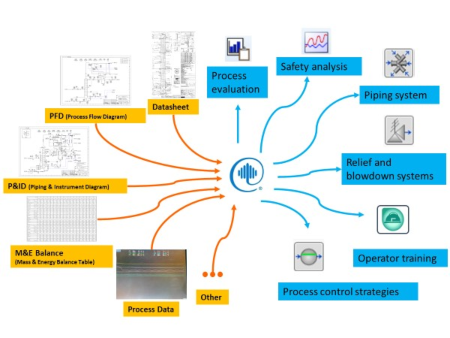2020 AFPM Summit: Optimized application of a virtual plant in chemical processing
Optimized application of a virtual plant in chemical processing
JUNG-CHIEH CHIU, CTCI Advanced Systems Inc.
CTCI Advanced Systems Inc. (CTCI ASI) has been committed to the development of smart technologies, green technologies and industrial upgradation. The company has invested in the development of process simulation technologies and applications for more than 30 years to solve problems in chemical processing by utilizing AspenTech® process simulation software (including Aspen Plus and Aspen HYSYS) to create virtual plants (FIG. 1) with plant data (design data and process historical data) provided by the customer.

FIG. 1. Required information and computable analysis for a process virtual plant.
Steady-state process simulation establishes a virtual plant that simulates the state of a continuous process plant during steady-state operation. Once the virtual plant model is in place, it is possible to use the accessible data to estimate specific plant data that is difficult to measure, as well as generate safety analysis and pipe network analysis for the plant. CTCI ASI provides a variety of services in virtual plant: process evaluation, safety analysis, pipe network analysis, operator training system, process control strategy analysis, etc. The company has performed numerous process simulation and improvement projects, with uncountable value and benefit to our customers (FIG. 2).

FIG. 2. Flowchart for building a dynamic virtual plant.
In practice, we established the virtual plant of a solvent recovery unit for a well-known pigments and specialty chemicals company. It was used to re-evaluate the process to understand responses under different conditions, and tests were conducted and data analyzed to find the optimal operation mode to suggest an improvement plan. As a result, the customer's solvent treatment unit not only reduced solvent loss by more than 2% and 70% of the solvent gas lost from the top of the distillation column, but also improved the purity and quality of the recovered solvent and doubled the capacity of solvent treatment.
Building a dynamic virtual plant. Dynamic simulation considers changes in plant operations over time, and the model is more complex and closer to the state of plant operation. Dynamic virtual plants require more information, and whether the data is complete or not is often the key to the model’s reliability. CTCI ASI first establishes a steady-state virtual plant, coupled with equipment-time-related parameters and controllers, and then "converts" it into a dynamic virtual plant. With a dynamic model of the process, we can further analyze the dynamic behavior of the process, such as the process control strategy, or apply this virtual plant to the operator training system. Various applications described enable the process plant to be analyzed by the virtual plant—from design to operation and maintenance—to enable the plant to operate in an optimal state. For instance, process compressors are important and expensive equipment within the plant. After entering the parameters of the compressor into the dynamic virtual plant, a surge analysis of the compressor can be completed to understand the behavior of the compressor under abnormal conditions, and then actions can be proposed to avoid safety issues and loss.
Challenges. The virtual plant of a process flow is not perfect, however. When it is difficult to accurately represent a system with sufficient information, the virtual plant’s reliability will be greatly reduced. At present, it takes a lot of time and computing resources to rebuild the entire plant in the simulation software for a large-scale chemical process. Considering that the process simulation software is still based on the equation of chemical engineering principles, without development of mathematical algorithms, continuous research on chemical engineering principles and breakthroughs in computer computing technology, process simulation cannot be a practical tool.
In the past, process simulation was focused on steady-state processes and has been applied in all phases of design, operation and maintenance. Dynamic virtual plants are an emerging architecture with potential, and they are closer to the actual plant and more suitable in a cyber-physical system. To complete the cyber-physical system, several aspects must be considered and solved. However, under the development of the dynamic virtual plant, a complete virtual and real integration system is closer at hand.
For more information, visit www.asi.ctci.com or www.ctci.com.
ABOUT THE AUTHOR

JUNG-CHIEH CHIU works for USI Group, Taiwan, as a Senior Planning Specialist responsible for evaluating novel technologies and promoting digital transformation. Before joining USI Group, he was involved in more than 12 projects related to process modeling and was appointed three times as a project manager at CTCI Group. He also served as a process modeling team leader and instructor of AspenONE® software. In his five-year career practicing process simulation, he served as an advisor for chemical process improvement and conceptual designs for petrochemical and chemical companies, and has created numerous rigorous process models, including three complex chemical processes.






Comments